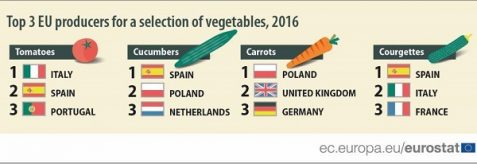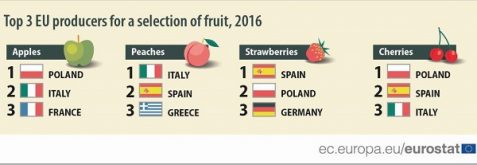 In the European Union, more than 2.8 million hectares have been allocated to fruit production and other 2.1 million hectares to the production of vegetables.
In the European Union, more than 2.8 million hectares have been allocated to fruit production and other 2.1 million hectares to the production of vegetables.
Eurostat has published the profiled rankings, where Romania, the seventh EU country by size and population, shines by its absence from all chapters.
It should be noted that Spain was the member state which paid the greatest attention to fruit production in 2016 (942 thousand hectares or 33% of the total surface), while Italy was the largest vegetable producer (420 thousand hectares or nearly 20% of the total surface).
For reference, we should mention that the country that should be a model for us on the path toward the European integration and reducing the gap with the West, Poland, has harvested more than one of four apples produced in the EU, easily surpassing Italy or France (28.7% versus 19.6% and 14.5% respectively).
At the same time, Poland was the main European cherry producer (29.3%), followed by Spain (11.9%), Italy (11.2%) and Hungary (9.9%). We also appear in this category and rank 5th, just slightly ahead of Greece (8.2% versus 7.9%). Poles ranked second in a category where we also could compete, namely the strawberries (17.4%), after Spain (31.6%), but ahead of Germany (12.0%).
The fact is that we made a fool of ourselves, given our soil and climate conditions, at the most important fruit and vegetable crops in the EU. It is about apples, which had a total production of 12.5 million tonnes or 25 kilograms per capita and tomatoes, which appear in the European statistics with 18.5 million tonnes or 36 kilograms per capita.
We have mentioned these figures to see that there is also room for a potential development of domestic production, especially given the superior quality of our products compared to the imported ones. The point is that we should function on the basis of intelligent work, with the focus on the national interests and not on personal interests and easy profits obtained from imports.
It is eloquent the situation of the tomato production (Romanian tomato might be sublime, but it is so sublime that is missing in Europe). Where Italy (35.5% of the EU production) and Spain (28.2%) are the big powers in terms of volumes but we are not visible and stand behind countries like Portugal (9.1%), Greece (5.5%), or the Netherlands (4.8%). And where the Poles (4.7%), even in the absence of a climate like ours, have reached such a level that they fight the Dutch.
And because they also like more to make money (from the salad of others), they got between the Spanish and Dutch on the cucumber segment (20.1% compared to 28.1% for Spain and 16.5% for the Netherlands). Besides, they took the lead in the carrot segment (14.7%), fighting the UK (12.9%) and Germany (11.5%).
So, from where and what we eat
We could not beat the ass and beat the saddle on the Poles topic because they had the most similar economy to us in terms of size, structure and level of development at the time of the Eastern Bloc and were somewhat similar in size and population. Unfortunately for us, the similarity did not also apply in terms of the level of organization, assiduousness and accessing the European funds, even though they did not have a European commissioner in the field.
As for Romanian consumers, in the absence of a more consistent national production that deserves to be included in the Eurostat releases and awaiting the rankings on the imports of vegetables and fruits, where we probably lead at the continent level, we provide you with the suggestions made by the EU body specialised in statistics:
- Apples and cherries from Poland,
- Peaches from Italy
- Strawberries from Spain
- Tomatoes from Italy
- Cucumbers
- Zucchini from Spain
- Carrots from Poland











